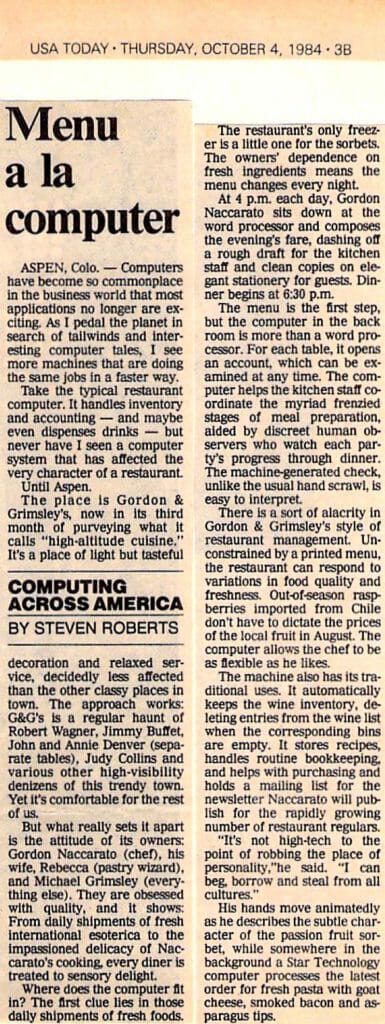
Menu a la Computer
My brief few months as a USA Today columnist in 1984 opened a few doors during the bicycle trip… exploring interesting ways people were starting to use personal computers. This interview reveals what were then some novel concepts (and it was an awesome dinner!)
by Steven K. Roberts
USA Today
October 4, 1984
ASPEN, Colo. — Computers have become so commonplace in the business world that most applications no longer are exciting. As I pedal the planet in search of tailwinds and interesting computer tales, I see more machines that are doing the same jobs in a faster way.
Take the typical restaurant computer. It handles inventory and accounting — and maybe even dispenses drinks — but never have I seen a computer system that has affected the very character of a restaurant.
Until Aspen.
The place is Gordon & Grimsley’s, now in its third month of purveying what it calls “high-altitude cuisine.” It’s a place of light but tasteful decoration and relaxed service, decidedly less affected than the other classy places in town. The approach works: G&G’s is a regular haunt of Robert Wagner, Jimmy Buffet, John and Annie Denver (separate tables), Judy Collins, and various other high-visibility denizens of this trendy town. Yet it’s comfortable for the rest of us.
But what really sets it apart is the attitude of its owners: Gordon Naccarato (chef), his wife, Rebecca (pastry wizard), and Michael Grimsley (everything else). They are obsessed with quality, and it shows: From daily shipments of fresh international esoterica to the impassioned delicacy of Naccarato’s cooking, every diner is treated to sensory delight.
Where does the computer fit in? The first clue lies in those daily shipments of fresh foods.
The restaurant’s only freezer is a little one for the sorbets. The owners’ dependence on fresh ingredients means the menu changes every night.
At 4 p.m. each day, Gordon Naccarato sits down at the word processor and composes the evening’s fare, dashing off a rough draft for the kitchen staff and clean copies on elegant stationery for guests. Dinner begins at 6:30 p.m.
The menu is the first step, but the computer in the back room is more than a word processor. For each table, it opens an account, which can be examined at any time. The computer helps the kitchen staff co ordinate the myriad frenzied stages of meal preparation, aided by discreet human observers who watch each party’s progress through dinner. The machine-generated check, unlike the usual hand scrawl, is easy to interpret.
There is a sort of alacrity in Gordon & Grimsley’s style of restaurant management. Unconstrained by a printed menu, the restaurant can respond to variations in food quality and freshness. Out-of-season raspberries imported from Chile don’t have to dictate the prices of the local fruit in August. The computer allows the chef to be as flexible as he likes.
The machine also has its traditional uses. It automatically keeps the wine inventory, deleting entries from the wine list when the corresponding bins are empty. It stores recipes, handles routine bookkeeping, and helps with purchasing and holds a mailing list for the newsletter Naccarato will publish for the rapidly growing number of restaurant regulars.
“It’s not high-tech to the point of robbing the place of personality,” he said. “I can beg, borrow and steal from all cultures.”
His hands move animatedly as he describes the subtle character of the passion fruit sorbet, while somewhere in the background a Star Technology computer processes the latest order for fresh pasta with goat cheese, smoked bacon and asparagus tips.

